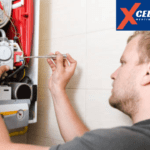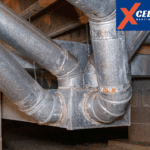

Buying a new furnace is a significant investment that impacts your home’s comfort and energy costs. Whether you’re a homeowner, family, real estate agent, or builder, choosing an energy-efficient model delivers lasting efficiency that brings uncountable concessions. When buy new furnace, it’s important to consider factors like efficiency, capacity, and cost-saving opportunities to ensure you choose the right furnace.
In this article, you’ll learn the 10 things you must consider while making a purchase decision that offers lasting benefits.
Installing a furnace is essential to making your house comfortable throughout the winter season. To achieve optimal performance and consistent efficiency, here is the list of factors you must consider to choose the right furnace according to your house’s needs:

Before choosing a furnace, it’s essential to understand your home’s heating requirements. You need to know prior factors like home size, insulation quality, and local climate. For instance, larger houses require extensive systems to warm the entire space, while small space houses can be warmed with the help of portable or standard furnaces.
To ensure a successful furnace installation, it’s important to account for the fuel type and system size before planning your budget. Natural gas furnaces are popular for their efficiency and availability, while oil furnaces offer a reliable alternative in areas without natural gas access. Wood and coal furnaces can be viable in rural areas, though they may require more maintenance. For a sustainable option, renewable energy systems like geothermal or solar-powered furnaces offer eco-friendly benefits.
BTU (British Thermal Units) is a measure of the furnace’s heating output. Choose a device with a higher BTU because it ensures consistent efficiency and saves on higher utility bills.
The AFUE (Annual Fuel Utilization Efficiency) rating is one of the most important indicators of a furnace’s efficiency. It displays a percentage of how fast the furnace converts fuel into heat.
Higher AFUE ratings, especially those above 90%, are typically more energy-efficient and can lead to substantial energy savings over time. It reflects that 90% of the fuel is consumed for energy production and only 10% of fuel is lost during operation.
Understanding BTU capacity is also considered an important factor when choosing a furnace for a home. Furnaces with high BTU output may heat up too quickly, causing short cycles, which can reduce efficiency and comfort. On the contrary, underpowered units struggle to maintain consistent warmth, leading to higher energy costs and quicker wear and tear.
To select the right BTU, consider your home’s square footage, ceiling height, insulation, and local weather conditions. To get lasting efficiency, consult with HVAC technicians to receive precise recommendations.
Many utility companies and government agencies offer rebates for furnaces to encourage homeowners to adopt sustainable heating solutions. These rebates can make a high-efficiency furnace more affordable by offsetting part of the upfront cost.
Look for rebates that exist in your region, and go for models that are eligible for those rebates. To find information on available incentives, search manufacturer’s websites, and local utility companies.
Furnace zoning is an advanced feature that allows you to control the temperature in different areas of your home independently. Especially useful in big houses where some rooms or floors may need extra heat than others do. Consider zoning for furnaces because it enables the increase of the temperatures selectively and thereby minimizes heat loss for houses consisting of two stories.
Furnaces come with types of burners, each with distinct efficiency and performance characteristics:
There are several types of furnaces to choose from based on the fuel source, each with unique advantages and disadvantages:
Modern furnaces often come with advanced features designed to enhance efficiency and convenience. Look for options like variable-speed blowers that can adjust airflow based on your heating needs or quiet operation for minimal disruption.
Smart compatibility is another factor you must consider. New furnaces are equipped with compatible smart thermostats where you can control heat remotely and track the usage of energy
It is imperative to perform regular maintenance so that your furnace will run at optimum capacity. While some types of furnaces may be easier to maintain or will simply need to be serviced more often than others—depending on the model. Consider the cost and availability of replacement parts and filters. Selecting a brand with warranties decreases future expenditures on repairs and prolongs life.
A high-efficiency model with a better AFUE rating may cost more initially, but it may cost far less in the long haul than a lower-efficiency furnace. Essentially, it is recommended to set up an installation budget with potential incentives for installation as well as potential operating costs. While making your plans on how to manage your budget, you should consider energy-efficient models and rebates.
Choosing to buy a new furnace is the process of finding the right model for your house within your specified budget. Considering factors like BTU capacity, AFUE rating, fuel types, available rebates and types of furnaces available helps you to make informed decisions that deliver lasting benefits in the form of energy saving and longevity.
You can also consult with an HVAC technician to get a better understanding of the available sources and choose according to your house requirements to achieve desired comfort for years. Contact us to get expert advice today!
The efficiency of the furnace can be determined by the AFUE rating, which displays an annual fuel utilization efficiency. Furnaces with higher AFUF are more energy efficient and produce maximum output.
Zoning means that different sections of the house require different temperature settings, and it will improve comfort and save energy bills when used on a heating furnace.
Single-stage burners are the simplest kind and are capable of operating at maximum power all the time. Two-stage burners are moderately efficient, whereas modulating burners are capable of the most intricate temperature adjustment.
Smart thermostats integrate with others and can be controlled remotely to increase heating efficiency and avoid energy waste.
You should consider factors like base price, installation cost, rebates, and running costs before installing a new furnace.